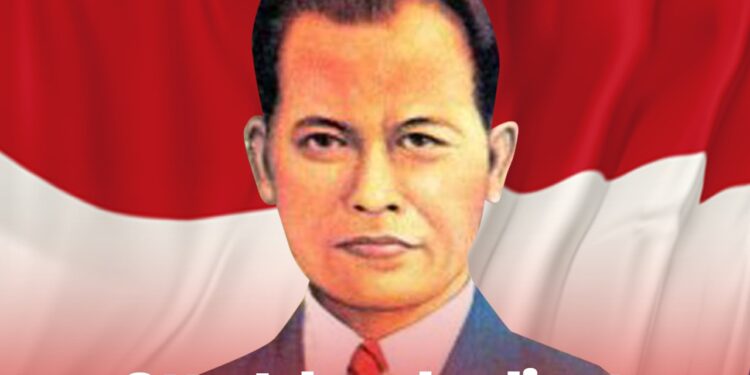The Harupat Starling, Otto Iskandardinata
JAKARTA – Even though it is popular and loud, it is rarely known. That is the description of the national hero from Muhammadiyah, Otto Iskandardinata.
His face is printed on the 20 thousand Rupiah denomination, issued from 2004 to 2021. Meanwhile, his name is used as one of the busiest and most famous roads in Jakarta and Bandung, namely Jalan Otista (Otto Iskandardinata).
But who knows his struggle for the Indonesian nation? Otto’s footprints were left behind in the history of the journey for independence, the founding of the PSSI (All Indonesian Football Association), to the founding of the TNI (Indonesian National Army).
Rooster from Bumi Pasundan
Raden Otto Iskandardinata was born on March 31 1897 in Bojongsoang, Bandung Regency. His father, Haji Rachmat Adam, was a descendant of a Sundanese nobleman named Nataatmadja. The privileges of a noble family meant that he had the best education.
After graduating from basic education at Hollandsch-Inlandsche School (HIS) Bandung, Otto continued on to Kweekschool Onderbouw (First Part Teacher School) Bandung. After that, he moved to Pekalongan to study at Hogere Kweekschool (Higher Teacher’s School) in Purworejo, Central Java and taught at HIS Banjarnegara.
The struggle through education was carried out by Otto because he thought that the Indonesian people would be free from colonialism if they were successfully transformed into a knowledgeable nation, according to Edi Kandhani’s opinion in the History of 20 December: The Death of ‘The Jalak Harupat’ Otto Iskandar Dinata.
After studying, Otto returned to Bandung in July 1920. There he became a teacher at HIS and the People’s College. In Bandung, Otto served as Deputy Chairman of the Bandung branch of Budi Utomo (BU) in the 1921-1924 period.
His movement with Budi Utomo led him to return to Pekalongan and become Deputy Head of the Pekalongan Branch BU in 1924 as well as being a member of the people’s council, Gemeenteraad (a kind of DPRD).
Since childhood, Otto has had high courage and doesn’t like small talk. Since becoming a student, Otto has also frequently shown outspoken criticism of the discrimination between native and Dutch children in education. This is what made him nicknamed ‘The Starling Harupat’, said Nina H. Lubis in Si Starling Harupat, Biography of Otto Iskandardinata (2003).
In Pekalongan it seems that the nickname ‘The Starling Harupat’ is increasingly sticking. Jalak Harupat is a name for a type of rooster in Sundanese which is mythological as a strong, brave, loud when crowing, always wins when fought.
While in Gemeenteraad, Otto, who had high guts and didn’t like small talk, often criticized Dutch planters who often acted harshly towards the natives. Not only was he diligent in speaking out, Otto also founded the Kartini School to educate young women in Pekalongan.
This attitude put Otto at odds with the Resident of Pekalongan and was considered dangerous by the colonial government due to the many sympathetic Pekalongan people. That was the reason why Otto was then transferred to Batavia.
Teaching at Muhammadiyah, Footsteps at Persija and PSSI
Upon arrival in Batavia before 1928, he was 30 years old. Otto joined Muhammadiyah and became a teacher at SMA Algemene Middelbare School (AMS) Muhammadiyah at Jalan Kramat Raya 49.
It was in this place that he became the Principal and invited other Muhammadiyah cadres who were also national heroes, Ir. Djuanda Kartawidjaja served as a teacher in 1933.
Otto was also the one who later recommended Djuanda to become director or principal of the school. That’s what Arya Ajisaka said in Getting to Know Indonesian Heroes (2008).
While in Jakarta, Otto also became a key figure in the Pasundan Community. As a football lover, Otto used this sport as a tool in the struggle for independence.
So it’s not surprising that when it was still in the spirit of the 1928 Youth Pledge, Otto allowed the building where he taught to be used as a meeting place for the founding of VIJ (Voetbalbond Indonesia Jacatra) or the forerunner of the Jakarta Football Association (Persija).
The meeting on October 20, 1929 which was attended by Mohammad Hoesni Thamrin, and the founder of VIJ, Soeri, was a form of Muhammadiyah helping the struggle of the Indonesian people against the invaders through football. That’s what Ario Josia said in Feature: Persija Muhammadiyah.
At the All Indonesian Football Association (PSSI), Otto is not part of the board of directors, but operates independently by managing the Sports Magazine which has been active in reporting on PSSI activities since 1930 with a touch of nationalism.
Member of BPUPK and proposer of Soekarno’s name as President of the Republic of Indonesia
While teaching at Muhammadiyah, Otto was drawn into being a member of the Volksraad (a kind of DPR) in 1935. During the Japanese colonial period, Otto became the leader of the newspaper Tjahaja which was founded as a reaction to the banning of the newspaper Sipatahunan (1942).
Towards the Proclamation of Independence, Otto served on the Preparatory Committee for Indonesian Independence (PPKI). In his capacity as a member of the committee, he participated in drafting the 1945 Constitution.
During his time as a member of the Investigative Agency for Preparatory Efforts for Independence (BPUPK), Otto was the first figure to propose Soekarno as president and then it was accepted unanimously by other BPUPK members who are mostly Muslim and Islamic students, wrote Abdul Munir Mulkhan in Marhaenis Muhammadiyah (2010).
Martyred Killed, End of Life for the Harupat Starling
After Indonesia’s independence, Otto served as Minister of State in the first Presidential Cabinet in charge of preparing the formation of the BKR from people’s militias scattered throughout Indonesia. The People’s Security Agency (BKR) was the forerunner of the Indonesian National Army (TNI).
Broadly speaking, at that time the majority of the paramilitary troops were split into two axes, namely former Japanese-trained troops, Heiho (Defenders of the Homeland) and deserters from the Dutch military (KNIL). His firmness in the idea of unifying these two different camps within the BKR is thought to have been the spark that ignited the murder of Otto Iskandardinata.
As a result of the slander he received as a Dutch spy, a group of soldiers dressed in black (Black Warriors) kidnapped him on Wednesday at 5 pm on December 19, 1945. Troops who came by truck from Tangerang took Otto to the beach in Ketapang Village, about 2 Km from Mauk. Together with another prisoner named Hasbi, Otto was tortured with his hands tied and then killed and their bodies thrown into the sea. His body was never found, according to the daily Ilmu Rakjat dated December 20 1952.
Otto’s murder was difficult to prevent, especially at that time Indonesia was in a critical situation. At the same time, on the afternoon of December 19 1945, the Karawang-Bekasi battle and war in several other areas occurred.
Deaths, kidnappings and killings of government leaders in West Java also frequently occurred at that time (1945), the Antara news agency noted on December 22, 1952.
The Indonesian government finally set December 20, 1945 as the death date of Si Jalak Harupat. Although his body was never found, a symbolic reburial took place at Taman Bahagia, Lembang on December 21, 1952.
The sand and sea water of Mauk beach were put in a coffin as a symbol of Otto Iskandardinata’s body. The funeral itself was witnessed by his friend, Djuanda, who at that time served as Minister of Transportation.
Otto Iskandardinata was appointed a National Hero based on the Decree of the President of the Republic of Indonesia No. 088/TK/Year 1973, November 6 1973.
In addition to a “Sand Heroes Monument” in Lembang erected to commemorate him, his brave name was transformed into the name of a sports stadium in the villages of Kopo and Cibodas, Kutawaringin District, Bandung Regency, namely Si Jalak Harupat Stadium.




